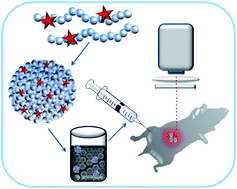Fluorescence imaging of cancer tissue based on metal-free polymeric nanoparticles – a review
Abstract
The utilization of fluorescent nanoparticles (FNPs), which consist of organic fluorophores embedded into a polymer matrix, seems to be a promising concept for in vivo cancer imaging showing good biocompatibility, biodegradability, and low toxicity of the agents. Polymeric nanoparticles as fluorescent nanocarriers can be systematically designed with regard to the requested task, i.e., specific accumulation in the tumor tissue. Versatile organic fluorophores can be entrapped into polymers with fine-tuned properties, which were synthesized via polymerization techniques. Moreover, the formulation of the nanoparticles can be adjusted, and passive as well as active targeting strategies can be employed. Despite their evident benefits, fluorescent polymeric nanoparticles are still not in clinical application for cancer detection due to a still existing lack of understanding of their in vivo interactions as well as their reproducible production. This review focuses on cancer imaging based on organic dyes and metal-free polymeric fluorescent nanoparticles highlighting recent interesting reports about their design and application as well as their limitations.


 Please wait while we load your content...
Please wait while we load your content...